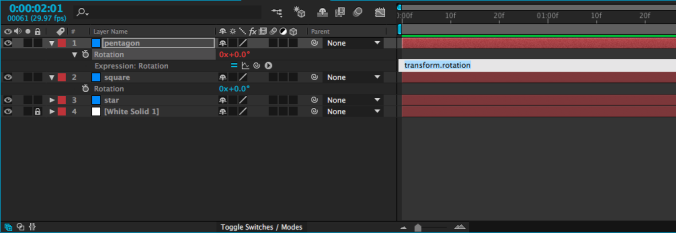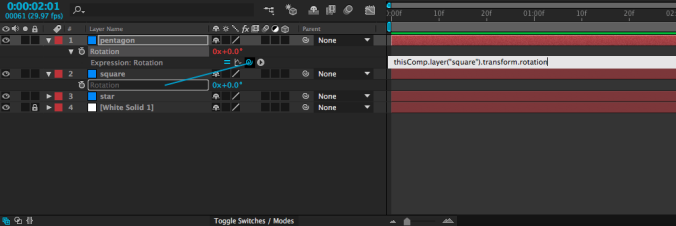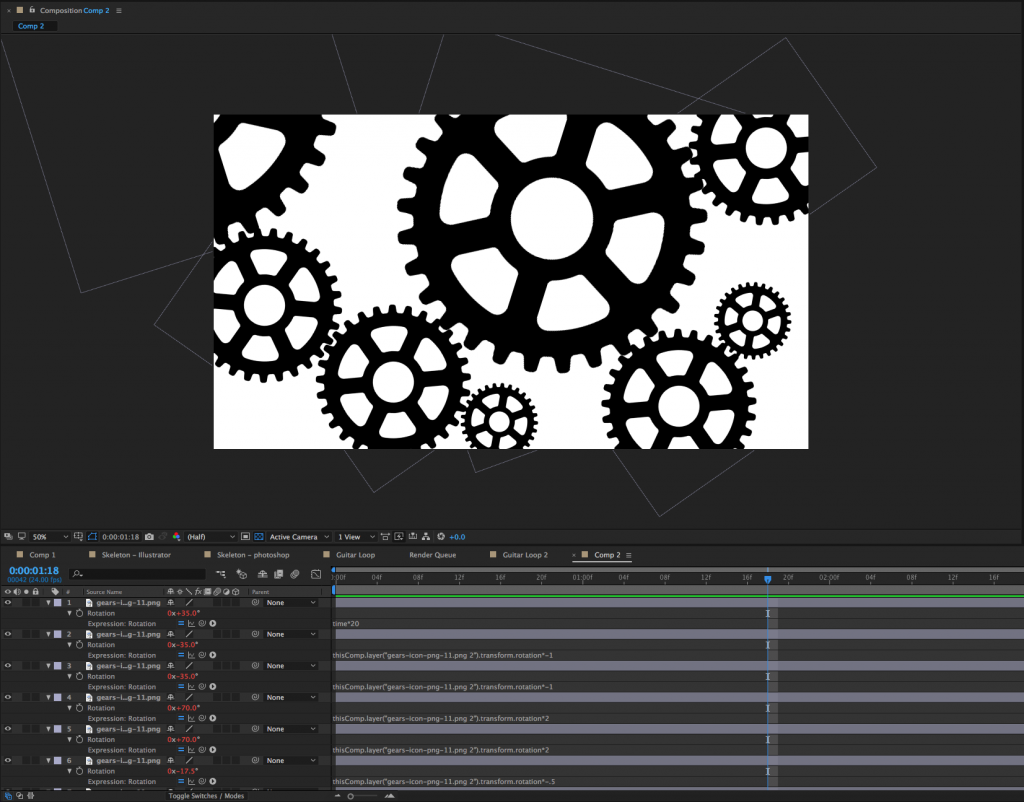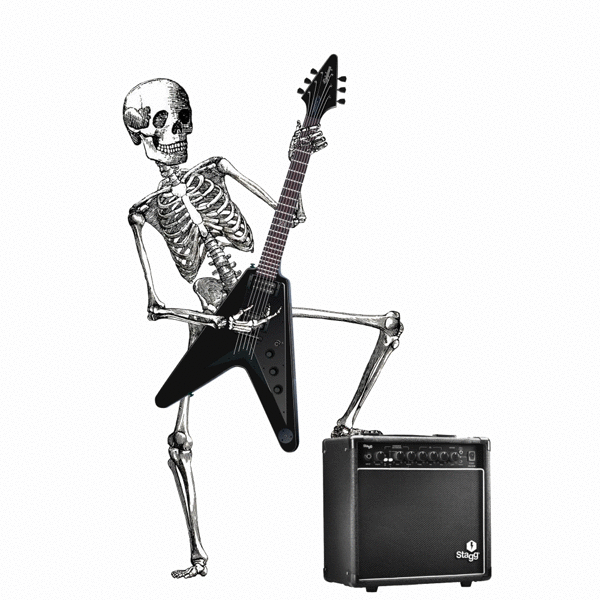Coding Animation
Adding keyframes is one way of animating properties in After Effects, but there is another method as well – using expressions. An expression is essentially a line of simple code that is applied to an animatable property. It’s not the same as writing computer code – you don’t need to know any specific programming language, or anything like that – but the idea is similar. To add an expression to a property, alt-click on the stopwatch icon that you usually use to turn keyframes on and off. The value associated with that property will turn red and a box of text will open in the timeline window. That window is where you add the expression.

Probably the simplest kind of expression – and one of the most useful – adopts the value of a property on another layer. For example, you could take the rotation value of one shape and apply it to the rotation of another shape. When you create an expression, four small icons will appear, one of which is the swirly “pick-whip” icon that we previously used to parent layers. If you use the pick-whip to select the rotation property on a different layer and then hit “enter” (or click outside the text box), whatever value is entered for that layer will be used for the layer with the expression.

I realize that may sound confusing, but it’s fairly simple in practice. It means that you can animate a single layer and use it to affect other layers. Simply animate the first layer, then use an expression on the others. Try it out – once you get used to the process, you might find yourself using this particular expression a lot.
One small thing to keep in mind as you are entering expressions: the “enter” and “return” keys do different things. One (enter) closes the text box, the other (return) adds a line to the current expression. You can also close the text box by clicking outside of it in the timeline. If you want to remove an expression, alt-click on the stopwatch icon again and it will return to normal. Expressions can also be used in conjunction with keyframes.

Math
One thing that’s neat about expressions is that they can be easily combined or modified. If, for example, you wanted to use the rotation expression above, but make the layer with the expression rotate the opposite way of the layer it gets linked to, that’s very simple. Just use the pick-whip to select the layer with animation, then type *-1 (multiply by negative one) after the expression in the text box and hit “enter.”

This technique can be very helpful for things like animating a bird flap its wings, since you can animate both wings with one set of keyframes. Furthermore, any changes you make to that set of keyframes will automatically affect both layers.

There are a lot more expressions that you can use to automate all sorts of properties in many different ways. One that you might come across uses the timecode of the composition, often multiplied by a number. If you add an expression to the rotation property of a layer and type time, the layer will rotate to one degree at the one second mark, two degrees at the two second mark, etc.. If you type time*100, it will rotate to 100 degrees at the one second mark, 200 degrees at the two second mark, etc.. This is a simple way to add continuous animation to a property, regardless of the length of the composition.
![]() I animated the gears in the example below without using any keyframes at all. The rotation of the first gear was set using the expression time*20. Every other gear’s rotation was pick-whipped to that first gear, with a multiplier, if necessary. By using some very simple math, I was able to animate the entire scene in such a way that changing the rotation of the first gear accurately changes every other gear.
I animated the gears in the example below without using any keyframes at all. The rotation of the first gear was set using the expression time*20. Every other gear’s rotation was pick-whipped to that first gear, with a multiplier, if necessary. By using some very simple math, I was able to animate the entire scene in such a way that changing the rotation of the first gear accurately changes every other gear.


Get Random
I’ve been using rotation in my examples so far, because it’s an easy property to visualize. Anything that can be keyframed can be affected by an expression, though – opacity, position, scale, and even the individual parameters of effects. One of my favorite expressions, wiggle, applies random values within certain limits. It can be used, among other things, to create unpredictable, organic-seeming movement when applied to the position of a layer.
To add wiggle to the position of a layer, alt-click on the Position keyframe icon in the Transform properties. A text box will open in the timeline – in it, type wiggle, then two numbers in parentheses, separated by a comma. For example: wiggle(2,150). The first number in this expression is the frequency: 2 equates to two times per second. Entering a 3 would be three times per second, and entering .5 would be half a time per second (or once every two seconds). The second number is the amount to move. So, our position expression “wiggle(2,150)” will move an object up to 150 pixels along the X and Y axis, twice per second. If our layer were 3D, it would move on the Z axis as well.

Of course, you don’t always want random movement, but it’s occasionally extremely helpful. I’ve used the wiggle expression to animate everything from fireflies to dials on a car dashboard. You can even apply a wiggle to a virtual camera to simulate the look of handheld footage. Randomness is more powerful than you might initially realize.

Wiggle can also be applied using an animation preset. These are found in the Effects & Presets panel (the same place we found the text animation presets earlier in the semester). If you type “wiggle” into the search bar, you’ll see a few different options there. The wiggle animation presets still use expressions, but they sort of do the coding for you. The presets work in conjunction with the Transform effect (in the Distort category), as opposed to the transform properties in the timeline panel.

Expressions open up a vast new world of possibilities in After Effects. The icon to the right of the pick-whip opens a window that contains dozens of “building blocks” – presets and pieces of expressions that can be combined to make very complex automated effects. Don’t feel like you need to understand what each of these does – instead, just get comfortable applying expressions. Often, online tutorials and trainings will provide expressions for you to copy and past into your own compositions. Like so much of After Effects, once you are familiar with the process, you can figure out the specifics as you go.

Project 10: Expressions of Terror
It’s almost Halloween, so let’s have some spooky fun! I’d like you to use expressions to create a spooky animated scene. You can create the media you use yourself, find some online, or use materials from previous lessons. Whatever you choose, you must use expressions at least three times in your animation. It doesn’t need to be long – maybe ten seconds or so – but make it scary and experiment with expressions!
